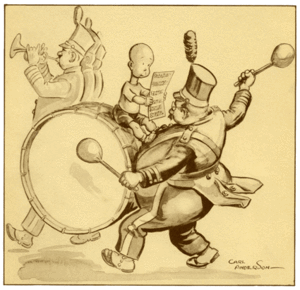Henry (comics)
| Henry | |
|---|---|
|
Henry (July 28, 1935) | |
| Author(s) | Carl Thomas Anderson |
| Current status / schedule | Concluded |
| Syndicate(s) | King Features Syndicate |
| Preceded by | Herr Spiegelberger, the Amateur Cracksman |
Henry is a comic strip created in 1932 by Carl Anderson. The title character is a young bald boy who is mute (and sometimes drawn minus a mouth). With the exception of a few early episodes, the comic strip character communicates only through pantomime, a situation which changed when Henry moved into comic books.
The Saturday Evening Post was the first publication to feature Henry, a series which began when Anderson was 67 years old. The series of cartoons continued in that magazine for two years in various formats of single panel, multiple panels or two panels.
From cartoons to comic strip
After seeing a German publication of Henry, William Randolph Hearst signed Anderson to King Features Syndicate and began distributing the comic strip on December 17. 1934, with the half-page Sunday strip launched March 10, 1935. Henry was replaced in The Saturday Evening Post by Marjorie Henderson Buell's Little Lulu. Anderson's Post cartoons featuring Henry are credited with early positive depictions of African-American characters during an era when African-Americans were often unflatteringly depicted.[1]

Anderson's assistant on the Sunday strip was Don Trachte. His assistant on the dailies was John Liney. In 1942, arthritis kept Anderson away from the drawing board, so Anderson turned the dailies over to Liney, and Trachte drew the Sunday strips. Liney retired in 1979. Jack Tippit then took over the dailies until 1983. Dick Hodgins, Jr. worked on the dailies from 1983 until 1995.[2] Trachte died in 2005. About 75 newspapers still run classic Henry strips. These are also available through King Features' Comics Kingdom.
Characters and story
Cartoonist Art Baxter analyzed the appeal of the character and the strip:
- Henry was a strip that was supposed to be contemporary, but it never looked that way. There were almost no modern trappings. There may be cars or telephones, but that's about it. It always seemed like Henry could always find the coal wagon, horse-drawn ice delivery or a five-cent ice cream cone. There were always shadings of nostalgia in the strip, even when it began in the Depression. Part of that has to do with the fact that Henry's creator, Carl Anderson, was already an old man in his late sixties when he created the character by accident. Henry is autonomous in The Saturday Evening Post strips. Henry would not pick up a regular cast of characters, all with no proper names, only titles: the mother, the dog, the bully, the little girl, until it became a William Randolph Hearst comic strip. The Saturday Evening Post Henry is similar in many ways to the Little Rascals/Our Gang comedies of the same era. That is children free from the tyranny of an adult presence (mostly). Children navigating the world as best they can with the knowledge and experience they currently possess. Sometimes they get things right, often get things wrong and frequently come up with solutions to problems unique to their limited experience. Necessity is the mother of invention with funny surprising results.[3] Later strips of Henry would be somewhat a reversal of earlier themes, such as adults having the last word when Henry and his friends misbehave, or Henry walking around town to see free samples of common household items, only to then see another sign advertising ice cream for expensive prices, to his unspoken consternation.

Derivative works
Henry appears (and speaks) alongside Betty Boop in the Fleischer Studios animated short Betty Boop with Henry, the Funniest Living American (1935).
During the period of 1946 to 1961, Dell Comics published 61 issues of a color comic book titled Carl Anderson's Henry. Henry spoke in the comic book, as did the other principal characters.
See also
- The Little King by Otto Soglow, an American pantomime comic strip that preceded Henry
References
Sources
- Strickler, Dave. Syndicated Comic Strips and Artists, 1924–1995: The Complete Index. Cambria, California: Comics Access, 1995. ISBN 0-9700077-0-1
